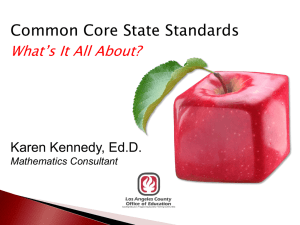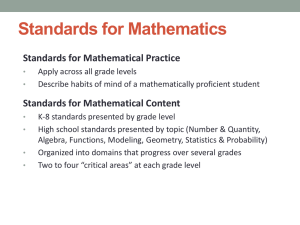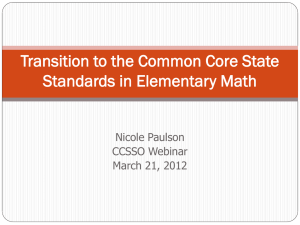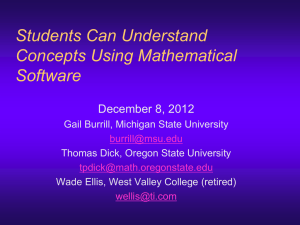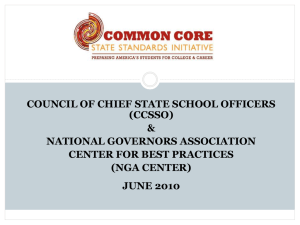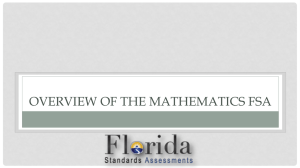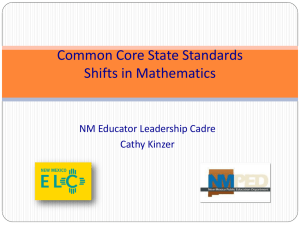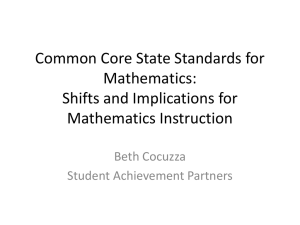this PowerPoint Presentation
advertisement
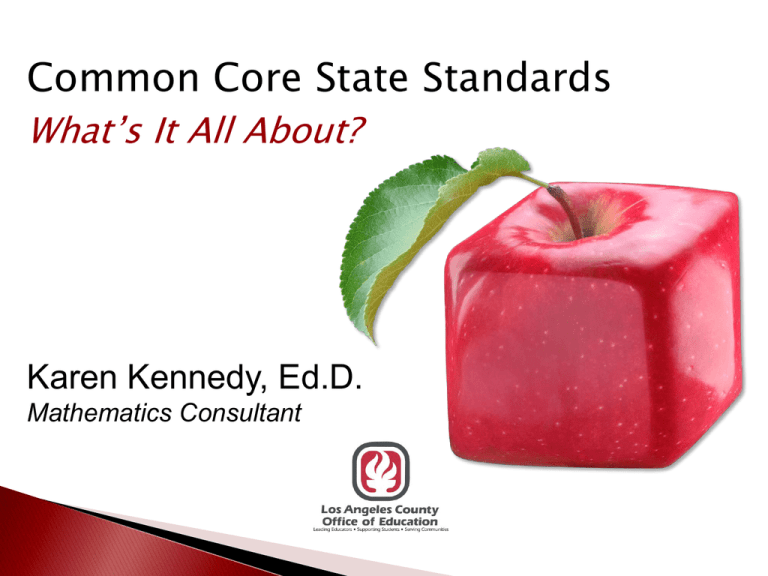
Common Core State Standards What’s It All About? Karen Kennedy, Ed.D. Mathematics Consultant “WHERE” THE MATHEMATICS WORKS Computational & Procedural Skills Problem Solving DOING MATH Conceptual Understanding “HOW” THE MATHEMATICS WORKS “WHY” THE MATHEMATICS WORKS Content Coherence Coherent progressions across grade levels. Balance of Concepts and Skills Content standards require both conceptual understanding and procedural fluency. Mathematical Practices Practices foster reasoning and sensemaking in mathematics. Standards for Mathematical Practice Apply •[1] Make sense of problems and persevere in solving them. •[4] Model with mathematics. •[5] Use appropriate tools strategically. Common Core State Standards •[2] Reason abstractly and quantitatively. Understand •[7] Look for and make use of structure. •[8] Look for and express regularity in repeated reasoning. CaCCSS pp.1-2, 47-48 Evaluate •[3] Construct viable arguments and critique the reasoning of others. •[6] Attend to precision. Standards for Mathematical Practice Carry across all grade levels. Describe habits of mind of a mathematically expert student. Describe varieties of expertise that educators should seek to develop in their students. Rest on important “processes and proficiencies” from the National Council of Teachers of Mathematics and National Research Council. Relate to mathematical proficiency as defined by the California Framework. Mathematical Proficiency Framework SMP Develop fluency in basic computational skills. Develop an understanding of mathematical concepts. Become mathematical problem solvers who can recognize and solve routine problems readily and can find ways to reach a solution or goal where no routine path is apparent. Communicate precisely about quantities, logical relationships, and unknown values through the use of signs, symbols, models, graphs, and mathematical terms. Reason mathematically by gathering data, analyzing evidence, and building arguments to support or refute hypotheses. Make connections among mathematical ideas and between mathematics and other disciplines. Make sense of problems and persevere in solving them. Reason abstractly and quantitatively. Construct viable arguments and critique the reasoning of others. Model with mathematics. Use appropriate tools strategically. Attend to precision. Look for and make use of structure. Look for and express regularity in repeated reasoning. Mathematical Proficiency Framework SMP Develop fluency in basic computational skills. Develop an understanding of mathematical concepts. Become mathematical problem solvers who can recognize and solve routine problems readily and can find ways to reach a solution or goal where no routine path is apparent. Communicate precisely about quantities, logical relationships, and unknown values through the use of signs, symbols, models, graphs, and mathematical terms. Reason mathematically by gathering data, analyzing evidence, and building arguments to support or refute hypotheses. Make connections among mathematical ideas and between mathematics and other disciplines. Make sense of problems and persevere in solving them. Reason abstractly and quantitatively. Construct viable arguments and critique the reasoning of others.* Model with mathematics.* Use appropriate tools strategically. Attend to precision. Look for and make use of structure. Look for and express regularity in repeated reasoning. *Not identified as an explicit practice in the Framework. Coherence Topics and performances are logical over time. Reflect hierarchical nature of the content. Are based upon learning progressions’ research on how students learn. Build upon learners’ schema (mental maps). Progressions Vertical articulation, i.e., domains progress over several grades. Organization K-8 standards are presented by grade level. High school standards are organized by conceptual themes (Number and Quantity, Algebra, Functions, Modeling, Geometry, Statistics and Probability). Grade Level Overviews CaCCSS p. 12 Grade Level Overviews CaCCSS p. 12 Content standards define what students should understand and be able to do. Clusters are groups of related content standards. Domains are larger groups of related content standards that progress across grade levels. Standard from Grade 3 CaCCSS p.14 K-5 Domains In grades K-5, students develop a solid foundation in whole numbers, addition, subtraction, multiplication, division, fractions, and decimals. CaCCSS p. 3(K),6(1),9(2),12(3),16(4),20(5) Middle Grades Domains With a strong foundation of content knowledge from grades K-5, middle school students are prepared for robust learning in geometry and statistics and probability. CaCCSS p. 24(6),29(7),42(CC8) K-7 Standards Focus on arithmetic and fluency with whole numbers at early grades. • In grades K-5, students develop a solid foundation in whole numbers, addition, subtraction, multiplication, division, fractions, and decimals. Fluency with fractions and decimals. • In grade three, students begin to develop an understanding of fractions as numbers and represent fractions on a number line diagram. • Addition and subtraction of fractions are introduced in grade four and multiplication and division in grade five. • The standards for grades six and seven extend work with fractions and develop concepts such as rational numbers and proportional relationships. Domai n Cluster of Standards The Number System [6.NS] Apply and extend previous understandings of multiplication and division to divide fractions by fractions. Compute fluently with multi-digit numbers and find common factors and multiples. Apply and extend previous understandings of numbers to the system of rational numbers. CaCCSS p. 24 Grade 3 Develop an understanding of fractions as numbers [3.NF]. Grade 4 Extend understanding of fraction equivalence and ordering. Build fractions from unit fractions by applying and extending previous understandings of operations on whole numbers. Understand decimal notation for fractions and compare decimal fractions [4.NF]. Grade 5 Use equivalent fractions as a strategy to add and subtract fractions. Apply and extend previous understandings of multiplication and division to multiply and divide fractions [5.NF]. Grade 6 Apply and extend previous understandings of multiplication and division to divide fractions by fractions. Compute fluently with multi-digit numbers and find common factors and multiples [6.NS]. Grade 3 Develop an understanding of fractions as numbers [3.NF]. Grade 4 Extend understanding of fraction equivalence and ordering. Build fractions from unit fractions by applying and extending previous understandings of operations on whole numbers. Understand decimal notation for fractions and compare decimal fractions [4.NF]. Grade 5 Use equivalent fractions as a strategy to add and subtract fractions. Apply and extend previous understandings of multiplication and division to multiply and divide fractions [5.NF]. Grade 6 Apply and extend previous understandings of multiplication and division to divide fractions by fractions. Compute fluently with multi-digit numbers and find common factors and multiples [6.NS]. Grade 8 Standards Algebra readiness by grade eight or Algebra 1. • The CCSS are consistent with California’s goal that all students succeed in Algebra 1. • Students who master the content and skills through grade seven will be well-prepared for algebra in grade eight. • With an expectation that all students continue their study of mathematics, the CCSS moves students forward with grade eight standards that prepare them for higher math (Algebra 1 and beyond). SBE’s Goal for Eighth Grade Students is Algebra 1 After taking Algebra in eighth grade, students could, theoretically, take three or four years of high school math to assure their placement at a UC or CSU campus. Because not all students have the prerequisite skills for Algebra, the SBE adopted two sets of standards for grade 8. Existing CA Algebra 1 Standards Common Core Standards for eighth grade (published June 2, 2010), which spread the instruction of Algebra 1 over Grades 8 and 9 and introduce Geometry in Grade 8. High School Standards: Conceptual Categories Are arranged by conceptual cluster, not by course. • Number and Quantity • Algebra • Functions • Modeling* • Geometry • Statistics and Probability Eighth grade Algebra 1 standards are organized around these themes as well. *Modeling Standard for Mathematical Practice is emphasized at the high school level. Students are expected to use mathematics to analyze situations, understand them more fully, and make decisions related to their everyday lives. (pp.60-61) CaCCSS p. 49(N),52(A),56(F),60(M),62(G),67(S) Theme High School Conceptual Theme Notation Domain Cluster of Standards CaCCSS p. 63 Grades 9-12 Standards Real world applications using modeling. • Throughout the standards, students apply the mathematics they have learned to solve problems that arise in everyday life, society, and the workplace. • The Standards for Mathematical Practice emphasize this skill and provide specific suggestions for modeling realworld situations using mathematics. • The high school standards include modeling standards throughout the other conceptual categories; these standards are identified with a star () symbol.* *Example: CaCCSS p. 53(A) High School Standards College and Career Readiness Preparation Standards specify the mathematics that all students should study in order to be college and career ready. Standards demand that students develop a depth of understanding and ability to apply mathematics outside of their classrooms. Standards are designated with a “+” to indicate material that students should learn in order to take advanced courses such as calculus, advanced statistics, or discrete mathematics. (The “+” standards may also be incorporated into courses that states require for all students.)* *Example: CaCCSS p. 53(A) Examples of California’s Additional 15%: CA added standards to develop ideas in… Grade 2: Operations and Algebraic Thinking 5. Use repeated addition and counting by multiples to demonstrate multiplication. 6. Use repeated subtraction and equal group sharing to demonstrate division. High School Geometry: Geometric Measurement and Dimension 5. Determine how changes in dimensions affect the perimeter, area, and volume of common geometric figures and solids (CA Standard Geometry 11.0). Examples of California’s Additional 15%: Some Common Core Standards from Grade 8 were shifted to Grade 7, and some Common Core Standards from Grade 7 were shifted to Grade 6. CA added its own Algebra 1 Standards to achieve the state’s goal of Algebra 1 for all eighth grade students. Like the high school standards, Grade 8 Algebra 1 standards are also organized by the high school conceptual themes. Examples of California’s Additional 15%*: CA also supplemented Common Core Standards in Algebra II, trigonometry, and geometry with key CA standards. CaCCSS include the addition of two courses: Calculus and Advanced Statistics and Probability. Development of course descriptions will be done by CDE as part of their long-range implementation plan. *Underlined standards in the CCSS document represent California’s additional 15%. What Now? Recognize that there are more similarities than differences in the current state standards and CCSS. Implement a truly balanced math program as this will support the Standards for Mathematical Practice. Continue to use quality assessments to inform and drive effective instruction. Provide opportunities for teachers to collaborate and plan. Resources California Department of Education • http://www.cde.ca.gov/ci/cc/ Sacramento County Office of Education • http://scoe.net/castandards Common Core Standards • http://corestandards.org Los Angeles County Office of Education • http://cis.lacoe.edu/common_core/
